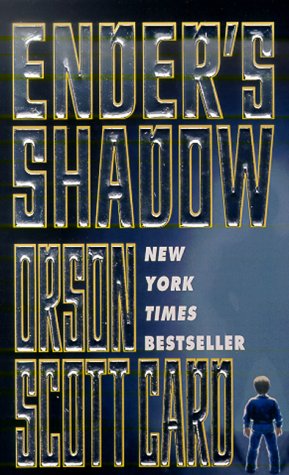"Children of the Mind" is the latest and last entry in the original Ender Saga, begun in 1985 with the publication of Orson Scott Card's "Ender's Game." I have heard reports that Orson Scott Card is writing another sequel set in the same universe, "Shadows in Flight," but from what I hear it would be grounded in the Ender's Shadow series, following the life of Bean and other secondary characters from the original novel. As it stands, "Children of the Mind" is the conclusion of the original saga, and what a ending it is!
Following the events of "Xenocide," the colonists of Lusitania have successfully neutralized the descolada virus, while their resident
deus ex machina Jane has mastered the art of instantaneous locomotion, which is handy in many situations, not least when you're trying to avoid a xenocide. The formic and pequinino populations (i.e.,"buggers" and "piggies") are no longer in danger of total extermination. However, these small steps forward come with several terrible steps back. The Starways fleet continues its course towards planet, now with the crucial commission to kill. Ender has lost his son to inter-species rioting, and lost his wife to fatalistic despair. Lastly, the citizens of Path have identified Jane, and found a way to squeeze the life out of her sentient circuitry -- eliminating in a stroke an entire species (Jane being one of a kind) and the future of space travel.
Moreover, Ender now has to deal with the presence of two newcomers to the community. Young Valentine and Young Peter were two empty bodies accidentally generated by on the first instantaneous flight: created
ex nihilo out of Ender's childhood memories, filled with Ender's own
aiua. Ender empties himself into the two creatures -- his dreams and altruistic nobility into the image of his sister, his desires and ambitious efficiency into that of his brother -- but at the cost of his own health and potentially his life.
With this many moving parts, it's only natural that the characters would all put their heads together and figure out the solution piecemeal, as each issue confronts them. Oh, wait, it's a Orson Scott Card novel. So, they all split up and frenetically multitask. Ender's friend Miro works with pseudo-Valentine to scout new worlds as destinations for Lusitanian colony ships, carrying humans and formics and pequininos. However, the pair soon notice that Jane is conducting her own line of research on the side, into the origins of the descolada virus itself. Meanwhile, psuedo-Peter flies off with Wang-mu (the servant girl introduced in "Xenocide") to persuade Congress to stop the fleet. Their first stop is the Japanese culture of Divine Wind, where they meet the philosopher Aimaina Hikari. Their conversation -- and the elaborate battle of wits that inform every word and action -- is one of the highlights of the book and the saga as a whole. From there, Peter and Wang-mu continue to Pacifica, a world of Samoan culture where they meet the prophet Malu. Finally, Ender himself remains on Lusitania, spending his final few days reforging his relationship with Novinha.
There are a few defining moments in the book -- the conversation between Wang-mu and Hikari being the first and perhaps the most notable. "Children of the Mind" contains the breadth of scope necessary for Card to fully develop his craft, not just in the three inter-weaving narratives, but also in the occasional glimpses into the thoughts of the Hive Queen, Rooter the father-tree, and especially Jane herself, on top of the brief passages and epigrams from Han Quin-jao (a character from "Xenocide") that open each chapter.
Moreover, this may be the first book in which the dichotomy between politics and psychology is no longer insurmountable for Card. They're still present, those near-diametric passages of emotional angst and political strategy, but the contrast is no longer so sharp, perhaps because Card is able to successfully recast both types of passages in terms of the other. Thus, that early conversation reveals high-level strategy and tactics, but is framed in the context of competing egos, while the passages that deal with Ender's three-part soul-split and Jane's final free moments on the ansible networks are reframed as puzzle pieces that must be sorted through to find a resolution.
This is a compelling book in itself, and a satisfying conclusion to the Ender Saga. I don't imagine Card is entirely done with the universe he's created, but if or when he returns I know I can look forward to even greater displays of method and ingenuity
If you're interested in purchasing this book, check out Amazon.com
Children of the Mind (Ender, Book 4)
For other reviews of the Ender's Saga and Shadow series, check out these links:
Ender's Game (13 Aug. 2010)
Ender in Exile (23 Sept. 2010)
Speaker for the Dead (8 Apr. 2011)
Xenocide (9 Apr. 2011)
Children of the Mind (11 Apr. 2011)
Ender's Shadow (15 Apr. 2011)
Shadow of the Hegemon (19 Apr. 2011)
Shadow Puppets (25 Apr. 2011)
Shadow of the Giant (29 Apr. 2011)

















